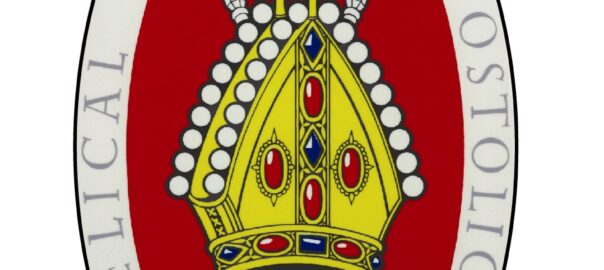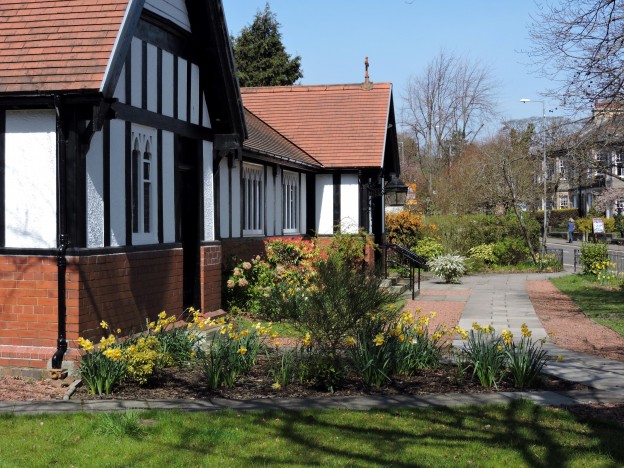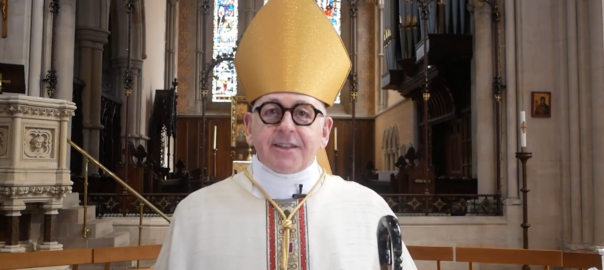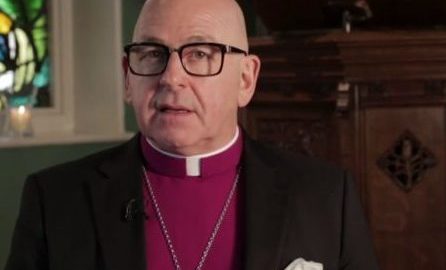For details of the Bishop’s 2023 Lent Appeal and information on giving visit here
For details of the Bishop’s 2023 Lent Appeal and information on giving visit here
At All Saints, we have restarted coffee after the morning service.
The Wednesday Lunches are now able to welcome congregation and friends.
With our new organist, the choir will be starting again in March. Anyone interested will be very welcome.
“Listen to the quiet voices” – The Primus, Bishop Mark Strange, looks at the hopes and expectations around COP26 as we seek to care for God’s creation As I write this, I’m sitting watching the leaves changing colour outside my office window. There’s a tree which is just at the corner of the churchyard at Arpafeelie which always begins to turn first, its leaves slowly, then quickly, becoming golden before plunging to a striking mix of reds then browns. As I have watched the autumn begin, the plants begin to bed down for the winter in this changing of the season; I remember that once the bare winter is over then the cycle will come round again. We will have the cool, clear spring and then the joyful warmth of summer. So it has been for much of my life. Yet as we have stayed at home over these past months because of the pandemic, I have appreciated the slow but ever-moving changing of the seasons in a new way. But just as I can anticipate the leaves coming back on that tree, it is becoming clear that in other places around the world many others no longer know what their seasons will hold. People can’t be confident that the rains will come, or know if their land will flood. People can no longer be confident that their crops will grow, or know if they will have the time and energy to harvest. People and places are struggling and dying now because of the twin crises of climate change and biodiversity loss. People are increasingly anxious and increasingly fearful, and there is growing anger and concern for the future. In Scotland we have a stable climate. As is so often the case, the worst affects of climate crisis will be felt that much more strongly in places where their climate is not so stable. So the changes that I can see, and the emotions which flow through me as I know they flow through many in our Church, are much more pressing in other parts of our world.  I’ve been thinking about those emotions and reactions as we all prepare for COP26 in Glasgow. The hopes and expectations of so many people are that political leaders will listen to the voices of people around the world who are simply frightened for the very ground they stand on and the lives around them. The Scottish Episcopal Church has put in place and will continue to develop processes which enable us to have a much lighter footprint on the ground, and will enable us to make a better use of the resource we have so that we don’t contribute to stripping the environment of those things which produce the very air that we breathe. I’ve been thinking about those emotions and reactions as we all prepare for COP26 in Glasgow. The hopes and expectations of so many people are that political leaders will listen to the voices of people around the world who are simply frightened for the very ground they stand on and the lives around them. The Scottish Episcopal Church has put in place and will continue to develop processes which enable us to have a much lighter footprint on the ground, and will enable us to make a better use of the resource we have so that we don’t contribute to stripping the environment of those things which produce the very air that we breathe.There will be moments of tears, moments of anger, and moments of laughter in Glasgow, but I hope there will be moments of prayer. Why are we going? Why is our Anglican Communion delegation gathering? It is because as a church, and as people of faith, that’s what we do: we pray. Our prayers are to God who created this beautiful little planet we all live on. Our prayers are that God will help us to do everything in our power to protect the environment we live in. With prayer, with conversation and simply by being visibly present, we can use the time to push home the point to political leaders that this crisis is real and that people of the world, especially those with the least ability to affect change, are being impacted by our continual drive for greater consumption, greater profits, and greater power. We will try and insist that they listen to the quiet voices, voices that might not be physically present, and we will pray again that world leaders make the right decisions for our planet. The Scottish Episcopal Church will be there along with old friends and hopefully new friends. We will spend our time carefully encouraging, noisily supporting and – I suspect – sometimes loudly reacting to what is happening because to honour God means caring for God’s creation, not simply for what it gives us but so that we can pass it on, healing and restoring, to those who will come after us. Please pray for all who will gather in Glasgow, for the leaders of the nations and those of us who will bring hope and prayer. |

Following a motion at last year’s Synod for a programme of actions to be brought to General Synod 2021 to resource the SEC in working towards the 2030 goal, the Church in Society Committee’s Technical Group on Climate Change presented a programme along with useful resources “aimed to equip the whole church for the urgent response that is needed towards achieving net zero carbon emissions”.
The Group has set out actions for different levels of the SEC to pursue, as congregations, dioceses, provincial level and as individuals; suggested more detailed action on buildings; listed useful resources; and indicated further work to be carried out. A Toolkit is currently in preparation, designed to provide practical recommendations for the implementation of action plans and including for instance a means of working out a church’s carbon footprint.
“The changes we need to make encompass almost all aspects of our life as a church; not only our buildings, but in every area where we burn coal, oil or gas,” reported the Group. “We need to transition to renewable alternatives as far as we possibly can, and where this is not reasonably practical, we need to reduce, save and offset. We do not underestimate the challenge. But there are many steps we can already take which will make a difference and we need to plan now for how and when the bigger challenges could be met.”
The Rev Dr Jenny Wright, Convener of the Church in Society Committee, spoke to the report, telling Synod members: “Achieving net zero by 2030 is no small feat. Neither are the obstacles insurmountable. I hope that the programme of actions, today’s presentation and the group discussions will be the first of many such conversations. This is merely a starting point – we recognise that support and resources on both provincial and diocesan level are necessary. Rest assured, you will not be left alone to reduce your carbon footprint and engage with climate action.”
Professor Donald Bruce, chair of the Technical Group on Climate Action, reminded Synod of the urgency of the need to take action, and the responsibility of everyone to contribute.
“We are not alone in this task,” said Prof Bruce. “There’s a movement right across the chorus in the UK and some excellent experience to draw upon from Eco-Congregation Scotland, it’s English equivalent: Eco-Church, the Church of England and Church of Scotland both have excellent expert energy advice which we can call upon. And this is real world rooted advice, based on what you can really do, on the ground in a real church.”
All four climate change motions were carried virtually unopposed, and the guidance and action documents were endorsed and commended. Within the motions, Synod also called on Standing Committee to put in place appropriate structures to enable action at provincial level, with Dioceses called on to do the same at congregational level. The SEC action plan document can be found on both the Provincial and our own web site.

Bishop Anne Dyer, the bishop of Aberdeen & Orkney is currently walking the St Magnus Way. The route begins on the small island of Egilsay where Magnus died and continues at Birsay on the mainland (the largest of the archipelago) where Magnus was originally buried ending in Kirkwall at St Magnus Cathedral where he was finally buried. The route follows the known route that his body was taken. There is a blog accompanying her pilgrimage on the diocesan web site.
“One thing that marked the pilgrims – they did not return home unchanged. I hope this is true for me.” +Anne
+Anne was interviewed by BBC Radio Orkney, the interview is available on BBC Sounds, her interview begins at 12min 30sec.
The route is just over 36 miles and covers some of Orkney’s most spectacular scenery and history. The way is marked by the St Magnus Way symbol a stylised ‘M’ and ‘W’ and a cross. The M looking like the undulating land the W like the waves. You can read about the St Magnus Way at the official website.

There are two options for worshipping at our 10.30am Sunday service. You can either worship at All Saints or join the live streaming via zoom.
You will find the liturgy here SL-1982.pdf (anglican.org)

‘He calls me by my name’.
‘Mary’ – It was to Mary Magdalene that Jesus first proclaimed that he had risen from the dead and he did that simply, quietly, gently but confidently by calling her ‘Mary.’
How do we know the power of the resurrection in our own lives? Simply remember – ‘He calls me by my name.’
According to John’s Gospel, Mary ‘turned.’ Jesus literally turned her life around, by using her name, ‘Mary.’ She recognised his voice, the call was simple, gentle, quiet but confident. Just as many of us experience the Holy Spirit in our prayers, our lives, we hear the call of God, of Jesus, because ‘He calls me by my name.’
Mary Magdalene, obviously, had spent a lot of time with Jesus and recognised his voice. The equally obvious parallel is that when we spend time with Jesus in prayer, and with help, we learn to discern the voice of Jesus and what God is genuinely saying to us, calling us to do and to be. We also learn to discern what are our own longings, our own fantasies of making the world as we want it to be. The first steps towards true discernment, of Jesus’ voice in prayer, through our experience, we are taught by Mary’s experience of Jesus.
By tradition, Mary was a notorious sinner, but she washed Jesus’ feet with her tears, in the Pharisee’s house. Jesus accepted her as she was, He understood who and what she was, but he recognised in her, who and what she might become, through the Holy Spirit. Lazarus, her brother died; again, her tears moved Jesus with compassion and Lazarus was raised from the dead. Acceptance, understanding that brings peace and hope.
Mary sat at Jesus’ feet while her sister, Martha, was busy, she chose to be with Him rather than doing things for Him. Mary recognised that in simply being with Jesus, she experienced that God was with her as He is with us. In the garden when she heard ‘Mary,’ she could say: ‘he calls me by my name’.
What in fact happened was Jesus called Mary to a new reality, based upon God’s acceptance, and understanding. That is the Hope of the resurrection in our own lives. Jesus lived, died, and rose again to prove that each one of us is made in God’s image and God is with us. The story of Jesus’ trial, crucifixion and death is the story of how all that is worst in human nature – jealously, anger, religious certainty – combined to kill all that is best in the human potential to love, where we can be with Jesus. As Jesus is with us in guilt, regret, anger, the tombs of our own experience, remember ‘He calls me by my name’ to a new reality.
There is much speculation as to when and how we can go back to normal. We can never go back; normal will never return and we will enter a new reality. That is the hope, promise, power of resurrection in our own lives. That is the real Hope of Easter, that human love in which we know, feel, experience that God is with us. That love is stronger than any natural phenomena, even death itself.
Mary Magdalene shed tears of grief in the garden. Jesus called her ‘Mary’ and the tears flowed, but now tears of joy and hope. Hope, all because – ‘He calls me by my name.’
The Lord is risen from the dead. Alleluia alleluia
He is risen indeed. Alleluia alleluia
+ Kevin

Dear Friends,
Hope is much more than mere optimism: that is the lesson of faith and that is why Lent is the Season of Opportunity.
Optimism, that feeling, view of life, that everything will work out well and that things can only get better and we have a right to expect everything to go well. That view of life offers a fraudulent certainty. Lent presents us with the God-given opportunity to recognise true Christian Hope, which is different from optimism.
Hope, true Christian Hope, is based on the vision that we want to be with God who is already with us in the love we experience; but that love gives us a vision of peace, fulfilment, security that we experience here and now but also teaches us to trust in God. That trust is the essence of faith – the vision. In other words, we live in what by tradition we call, ‘the Hope of Heaven’.
It was the late Lord Jonathan Sacks, who made the distinction between Optimism and Hope. Lord Sacks, as Chief Rabbi, said that the history of the European Jewish community in the twentieth century meant that they could not be optimistic, but they lived in Hope. Without that Hope in God, their community could not have continued. Their experience taught them that things do not always just turn out well, but that God is faithful to his people and Hope in God and in God’s faithfulness leads us into a new reality.
That is the Hope that makes Lent the season of opportunity. That is the Hope that in Lent 2021 gives to each one of us the opportunity to embrace our own new reality. In tiny, trivial ways, giving up biscuits for instance. Amidst all that we have been denied, had to give up in these past months, during Lent, as we reach for the biscuit tin, reflect on the many people who have found themselves at food banks for the first time in their lives.
Take that thought and that reflection into bible reading, prayer, and Zoom worship. Listen, read, the scriptures assigned for these weeks of Lent. Notice the optimism of the disciples from the mount of Transfiguration to the glory of Palm Sunday. On Palm Sunday they felt, they knew, they were on the winning side, but that soon proved to be false optimism.
The desolation of Holy Week and the tomb, but God’s faithfulness, Jesus, with us in the desolation, there is Hope. Hope of the glory of light and life on Easter Day. The new reality that God is with us but the excitement that we can be with God, God who is love.
Hope lives. The scriptures teach us that, as our communities reflect on the need for food banks, a more just and equitable society must be our hope of the new reality. The Holy Spirit spoke through Isaiah, the prophets, that justice, peace, security are God’s yearning for us all.
During Lent, there are many opportunities online, in books, in conversations with those leading our congregations, for us all to reflect on scripture in prayer. Seize the opportunity to embrace the new reality, the journey to and with God, offered this Lent. To bring to ourselves, to share with others, the Easter new reality of Hope that is eternal.
I wish you all a happy and Holy Lent.
+ Kevin
Glasgow and Galloway

Christmas 2020
Dear Friends
People constantly attempt to make the Christian faith much more complicated than it actually is. The whole of Christian preaching and teaching can be summarised in one short word – LOVE. And the paradox is you can’t write about love, you can’t read about love, you can’t preach about love, you can only ever experience love. And that is the abiding fascination of the Christmas story because we first experience love in the love of family and of friends, the warmth the affection, the security of being held: there is love. Love that is of God, love that is real and experienced and is secure and in which we are understood, cherished, wanted.
They are all facets of the story of Mary and Joseph and the baby Jesus. It is a fascinating story because it is so real, so human, so ordinary, and the real magic of Christmas is that we are reminded again of just how extra-ordinary the story of human love and birth actually is.
Who can fail to be moved at the sight of a small infant? Tiny hands, tiny feet, big blue eyes, a baby sleeps. The vulnerability, the need, the dependence of such tiny hands and tiny feet. At the same time, even the most hard-bitten bishop is moved at the sight because there in those tiny hands and tiny feet, looking through those big blue eyes, is so much potential. In the baby Jesus we see the true hope, the potential of being human.
How many parents have looked at their new-born baby and resolved to be better people, more caring, more understanding, more accepting? How many of us have read the story of Jesus and have longed, yearned to be more kind, generous, caring and loving? The importance of the story of Christmas is that it is the story of each one of us.
The babe of Bethlehem grew to endure misunderstanding and loneliness, pain and suffering, disappointment and failure. Jesus brought out of all those facets of our lives that we would rather be without. He brought joy that is profound and real, life-giving and peace-making, experiences of love in which God makes himself known. Covid has taught many of us to recognise God in the most surprising small acts of generosity and kindness, through which we have recognised the full human potential to love and have heard again the message of the angels – to allow ourselves to be loved. That is the simple lesson of faith in love, which we experience new every morning and yet it is the message which is eternal.
This Christmas time – look at a baby and see God.
May all God’s blessings be yours this Christmas time
+ Kevin

In this challenging situation, what do we have to offer? We offer hope. There is hope, even in, especially in the midst of pandemic and legal restrictions. There is hope in our faith that love is the source of all life and energy. The truth is that the love Jesus showed on the cross, in his passion and death, that love is self-giving and endures all things. The stories of Jesus’ resurrection show that love is of God, it is the hidden force in our world and in our lives. It transforms and transfigures our entire experience. Love is stronger than hate, which killed Jesus. There will be a vaccine because, in love, many scientists and medics are working to find the formula. Many people are prepared to test the experimental vaccine. That is the truth of love which is proof of its power. The truth that we know in faith, that love is the hidden force which transfigures and transforms our lives and builds the Kingdom of God in the communities in which we find ourselves. There is hope, also when some of our churches decide they must close again for a while because of the new restrictions. As I said at the beginning of the pandemic, we close our doors in love, not in fear. Let us always remember that we live in the hope of new life. Let us share that hope, in whatever small ways we can. A phone call to someone on their own, shopping for those who are vulnerable, sharing through food banks… There is hope! And always, we pray in the hope and the certainty that love is of God, love is stronger that hate or any natural phenomenon. That is the love that we share, and in the sharing, we make God’s presence real. In this time of crisis, please be in touch if there is anything I can help with. In the sure and certain hope of God’s love and presence, + Kevin Glasgow and Galloway 17 November 2020